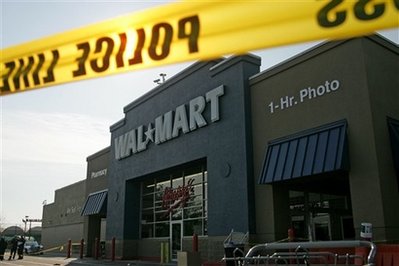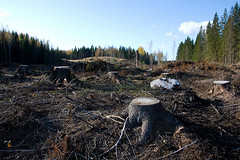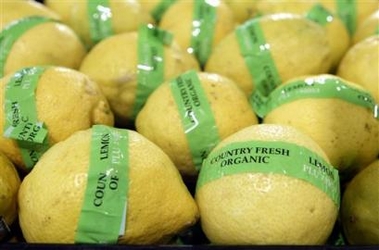Yes, Walmart is bad

Nassau County Police examine the front of the Wal-Mart in Valley Stream, N.Y., Friday, Nov. 28, 2008, after a temporary Wal-Mart worker died after a throng of eager shoppers broke down the doors and trampled him moments after the Long Island store opened early Friday for day-after-Thanksgiving bargain hunting, police said.(AP Photo/Ed Betz)
Stacy Mitchell, of the New Rules Project, and author of the Big Box Swindle, has released a paper challenging the conclusions of a pro-Walmart journal article published in an economics journal. See "Major Flaws Uncovered in Study Claiming Wal-Mart has not Harmed Small Business."
Her article is quite good, and makes some important points even beyond pointing out the methodological errors in the original study:
-- while the U.S. population has increased significantly, the number of independent retail businesses has not increased at the same rate
-- retail chains continue to capture an inordinate share of total retail sales
-- more "retail" space in traditional commercial districts is likely being converted from retail to non-retail use.
This is timely because I have been pondering and been meaning to write about this blog entry, "Creative destruction from Wal-mart’s arrival," from All About Cities, which reports on a Canadian study that has a similar finding, that Walmart isn't all bad, that their entry into various retail markets improves the quality of what is offered by the surviving stores.
It's true that a lot of independent retailers could do a much better job and that the entry of Walmart to their market leads to changes, good and bad. But one point that the Canadian study seems to miss is that while business may increase for other stores in the immediate or nearby area where the Walmart locates, this usually comes at the cost of loss of sales in other commercial districts in the greater retail trade area served by the store.

Clear cutting, Flickr photo by talaakso.
The entry of chain stores often has an impact on a traditional commercial district comparable to clear cutting a forest. For various reasons, single store operations aren't able to price products competitively vis-a-vis (inter)national retail companies with tremendous buying power and global supply chains.
As a result of national chaining of retail generally, not just Walmart, a large number of categories, in particular convenience goods categories such as apparel, food, pharmacy, housewares, often hardware, etc., become uncompetitive as far as local retailers are concerned, and increasingly, these categories end up not being represented in traditional commercial districts, except at the specialty goods level and higher price points.
This leads to big gaps in the type of retail categories represented in local commercial districts, which become lopsided and narrow as a result, and more dependent on specialty retail and on attracting market segments outside of the local area (i.e., tourists).

This is a graphic I invariably include when I write retail-commercial district assessment plans for communities, although I change the "brands" included to reflect stores located within the region being studied. The "chaining up" of retail has eliminated various price points and categories from many traditional commercial districts, especially those with limited population.
Another factor that appears to be ignored is the negative impact on other aspects of the local economy, by the displacement of local purchases in favor of national sourcing. For example, often Walmart doesn't advertise in local newspapers. And they don't purchase goods and services (i.e., accounting, legal, printing, etc.) locally compared to locally owned retail stores. This has a negative effect on business maintenance within the local retail trade area and reduces the breadth of services available.
Neither journal article gets these issues, instead repeating the kind of advice contained in the book "Up Against the Wal Marts" about shifting the store's product mix towards items and price points that Walmart doesn't carry.
Although the problem with this "strategy" is that over time, Walmart continues to add more product lines and a greater variety of products and price points, further constraining the ability of other stores to compete within a Walmart store's retail trade area. Walmart now has some upscale stores, such as in Plano, Texas.

A display of organic lemons is shown at a new upscale Wal-Mart store, Tuesday March 21, 2006, in Plano, Texas. The new store, complete with organic fruits, microbrewery beer, fine wine and cheese and plasma TVs, is set to open its doors Wednesday. (AP Photo/Amy Conn-Gutierrez)
I have written before about how Walmart's retail strategy is to capture ideally 100% of the retail expenditure of a consumer. Their success comes at the failure of satellite commercial districts and various stores. But it's true that the prices are low. OTOH, who really is making the money from the sale? While China gains, the U.S. economy loses, especially in terms of being able to manufacture goods in the United States.

Bizarro comic, 5/8/2006.
Labels: commercial district revitalization, formula retail, neighborhood planning, retail, traditional commercial districts



0 Comments:
Post a Comment
<< Home